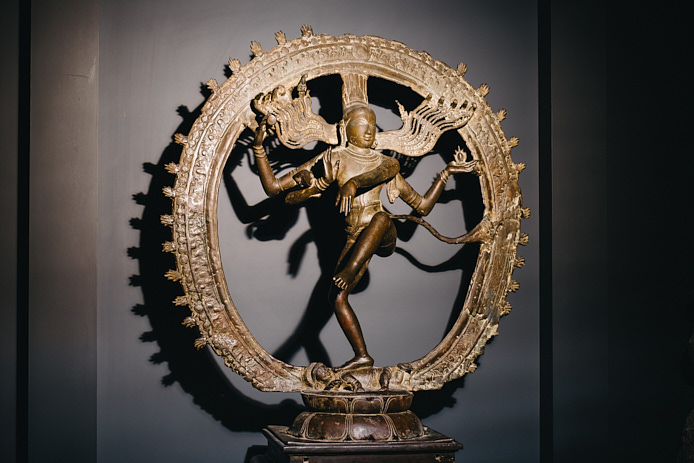Startseite > Of Love and War
The large temporary exhibition of the state of Baden-Württemberg showed the history and present of Tamil culture. Over 80 million people in India, Sri Lanka and other parts of the world identify themselves as Tamils: They share the same language, Tamil, which originated in the south of India. “Of Love and War” sought to bring their history and stories to life in a variety of ways, with different people sharing their stories about Tamil cultures and identities. They spoke about social movements, performing and visual arts, aspects of everyday culture and religious diversity.
The exhibition showed archaeological objects attributed to the Caṅkam period, a selection of bronzes from the Cōḻa dynasty (9th-13th century), as well as works by artists of the Madras Art Movement from the second half of the 20th century. Social aspects of history were also highlighted with the caste-crossing Bhakti mysticism of the Middle Ages, the “Dravidian movement” of the 20th century and the struggle of the Liberation Tigers of Tamil Eelam for a separate Tamil state in Sri Lanka, which lasted until 2009.
Love and War, akam and puṟam
The Tamil language is a language of poetry. It has been spoken for over 3,000 years and conveys the culture and values of the Tamil people. Poets have always been highly esteemed and regarded as moral authorities. They joined together in so-called Caṅkams and created literature that is influental today and unites the speakers of Tamil beyond states, castes and religions. This early poetry in particular knew two main genres of artistic expression: akam and puṟam. Akam means the internal, the personal, that which is about love; puṟam, on the other hand, is the external, the public, that which is about war. These two sides were present throughout the exhibition – in the stories told as well as in the exhibits on display. Tiṇai also appeared time and again, using images from the landscapes of South India in poetry, art and pop culture to refer to “inner landscapes” and the emotions associated with them.
Religious diversity
The exhibition also made it possible to experience the great religious diversity that exists in southern India. In addition to elegant statues from the temples of the Cōḻa, a village shrine to the god Aiyanar and the construction of colorful Kolu figures, historically significant objects from the heyday of Buddhism and Jainism were also on display. Muslim and Christian culture were also present in the south of India at an early stage and had a weighty influence on Tamil culture and art. For example, the Sufi order, established by Muslim traders, was very popular because of its intensive exchange with Hindu spirituality. Shrines over the graves of famous Sufis, known as dargahs, developed into transreligious pilgrimage sites for Hindus, Muslims and Christians.

Worldwide collaborations
The exhibition was curated by Dr. Georg Noack (Linden-Museum Stuttgart) and Dr. M. D. Muthukumaraswamy (National Folklore Support Centre) from Chennai. In addition, we have invited partners from different parts of the world to contribute their perspectives on aspects of Tamil culture, art, history and religions. In various modules – poetry, social movements, art, popular culture, religion and everyday life – “Of Love and War” thus created a dense description from diverse positions and perspectives. We also owe many of the objects shown in the exhibition to worldwide collaborations. In addition to exhibits from our collection, we were able to present loans from the Museum Rietberg Zurich, the Musée National des Arts Asiatiques Guimet in Paris, the Museum for Asian Art Berlin, the Danish National Museum in Copenhagen and the Religious Studies Collection of the Philipps University of Marburg. The exhibition also included old inscriptions, manuscripts and prints from the Leiden University Library, the Rojah Mutthiah Research Library in Chennai, the archive of the Francke Foundations in Halle and the Württemberg State Library in Stuttgart.
Exhibition booklet for children: Ganapati – Bringer of luck and companion
Ganapati accompanied children through the exhibition with puzzles and tasks. Ganapati, who is also known as Gaṇeśa, is worshipped as a bringer of luck. With him, the children got to know important poets and religious figures, looked at works of art or wrote a few Tamil words.
Dienstag bis Samstag, 10 – 17 Uhr
Sonn- und Feiertage, 10 – 18 Uhr
Ausstellungen
Sonderausstellungen
Dauerausstellungen